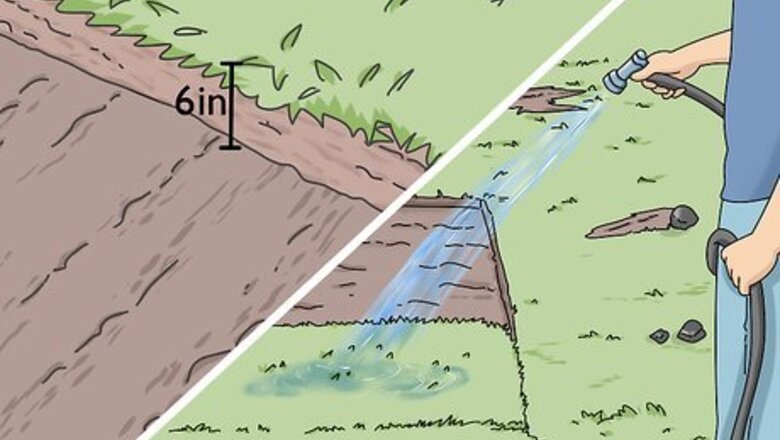
views
Watering and Fertilizing the Sod
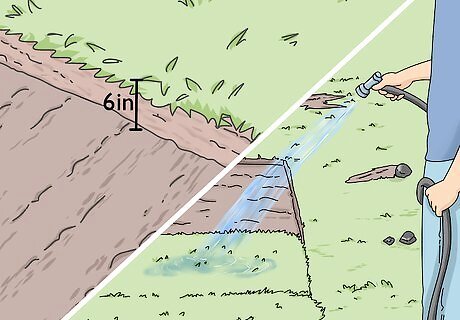
Irrigate the sod 6 inches (15 cm) deep every day for the first week. Every sprinkler has a different output, so keep track of how much water has been used by setting flat-bottomed dishes or tins in the path of the sprinkler. Water the sod this deep every day for the first week to encourage it to take root. You can also check how damp the soil is and how deeply it’s watered by pulling up a corner of the sod. Use your finger to see how far down the soil is moist. If it rains a lot during the first week, you may not need to use a sprinkler system on the sod. Use the flat-bottomed dishes to keep track of rainfall.Tip: It’s almost impossible to give sod too much water, so don’t worry about overwatering, especially for the first couple of weeks.
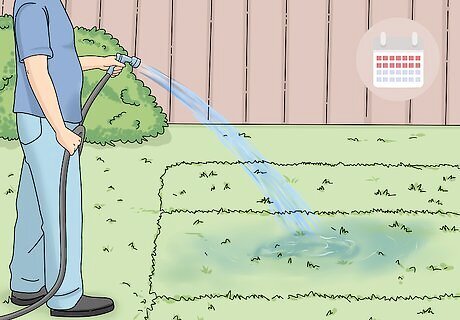
Water the sod for 40 minutes per day during the second week. After the first week of drenching the sod with water once per day to help the roots begin to grow, switch to a more frequent watering schedule rather than focusing on the total water output. In total, give the sod about 40 minutes of water each day. You can split up the time as needed depending on how quickly the water evaporates throughout the day because of heat or humidity. For example, if you live in a dry location, more frequent waterings will keep the soil consistently moist. If you live in a more temperate area, less-frequent waterings will work. If you’re not home during the day, invest in an irrigation system that works on a timer. Check the soil by pulling up the sod. If the soil is moist, that is great! If it’s dry, increase how often or for how long you’re watering the sod.
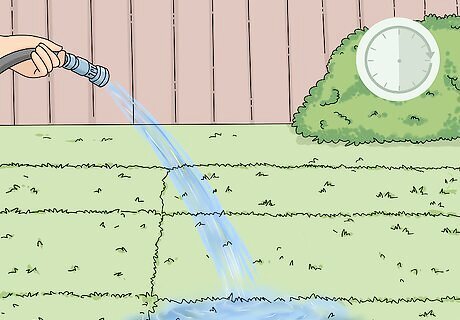
Water the sod 1-2 times per day for 30 minutes after it has taken root. On weeks 3 and 4, the sod should be rooted and ready for less frequent but longer-in-duration watering sessions. The longer watering times should encourage the roots to continue growing deep. Pull on the sod to see if it has taken root. If it still lifts easily, it hasn’t yet. If there is resistance when you pull, it has started to take root.
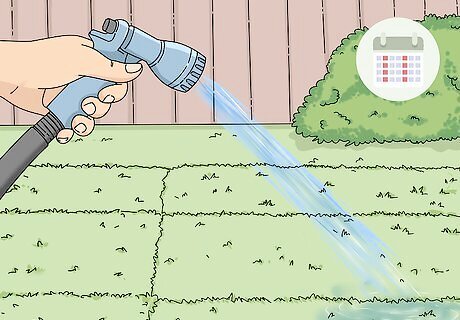
Reduce waterings to twice per week after you start mowing the sod. Generally, the sod is ready to be mowed sometime after 4 weeks. Each week after that point, you should give the sod 1 inch (2.5 cm) of water 2 times per week. Follow this watering pattern from here on out. Continue keeping track of the water output by using a flat-bottomed container.
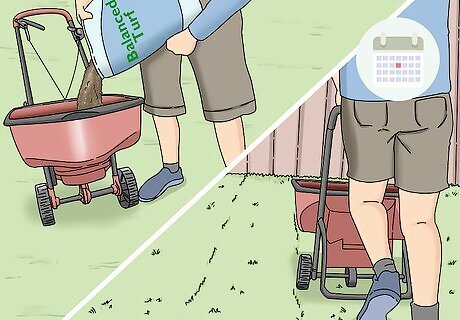
Fertilize the sod once per month after it has taken root. Buy a balanced turf fertilizer from your local nursery or garden supply store. Look for a product with a nutrient ratio of 3:1:2 (nitrogen to phosphorus to potassium). Use a drop spreader or a rotary spreader to disperse the fertilizer, and then water the sod thoroughly afterward. How much fertilizer you need depends on how big your lawn is. Measure your yard’s length and multiply it by the width to get the square footage. Read the directions on the fertilizer to determine how many pounds of fertilizer you need for that amount of space. Many brands recommend not watering the sod for 1-2 days before applying the fertilizer. Make sure to check what is recommended for the best results.
Mowing the Grass
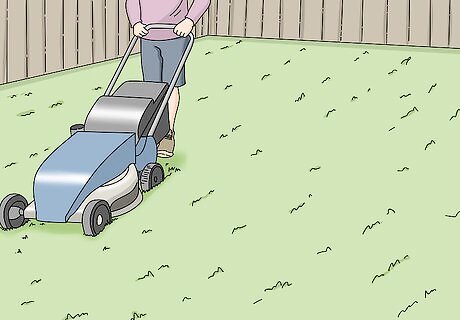
Mow the sod for the first time about 14 days after planting it. The first 14 days after the sod was laid are important for it to take root, and you should avoid walking on it at all costs. But after it has started to take root, you can go ahead and mow it, as that will encourage it to keep growing. Avoid mowing the sod if the soil is very moist. You could even stop watering the sod for 1-2 days before you plan to mow it.
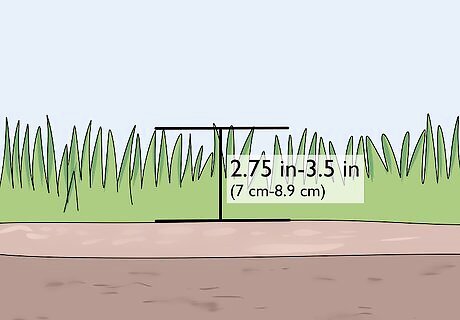
Keep the grass between 2.75 and 3.5 inches (7.0 and 8.9 cm) long. When you cut the grass, try to not cut off more than one-third of the grass’ total height—cutting it too low could kill it or stunt its growth. Depending on the time of year, you may need to mow the sod twice per week or once every 2 weeks. Keep an eye on its growth and mow it once the blades hit the appropriate height. Use a ruler to measure how tall the grass is. Wintertime generally requires much less frequent mowings, whereas spring and summertime usually mean quick growth and more frequent mowings.
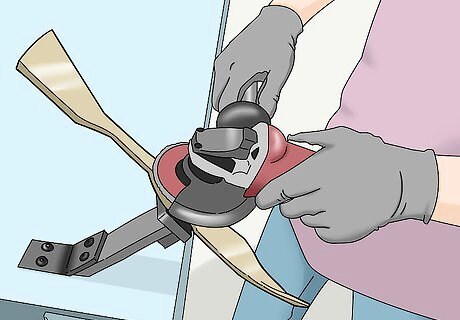
Sharpen the mower’s blades every 4 weeks to ensure healthy cuts. If the blades are dull, the grass won’t recover as quickly from the trim and it could even cause disease to spread. Clean off the blades first so there aren’t grass clippings on them. Always read the mower’s instruction manual for safety precautions and procedures on how to sharpen your mower’s blades.Warning: Depending on the type of mower you have, you may want to prop it up on blocks to remove the blades rather than tipping it onto its side. Tipping it could accidentally flood the engine with fuel or send oil to places it shouldn’t go. Check out your user manual to see what method of blade removal is recommended.
Maintaining Your Yard

Avoid walking on new sod until you need to mow it for the first time. If you need to move sprinklers, that’s okay, but keep foot traffic to a minimum to keep the sod as healthy as possible. Do your best to keep pets off of the sod, too. In general, it’s recommended to never park your car on sod and to keep excess weight off of it long-term.
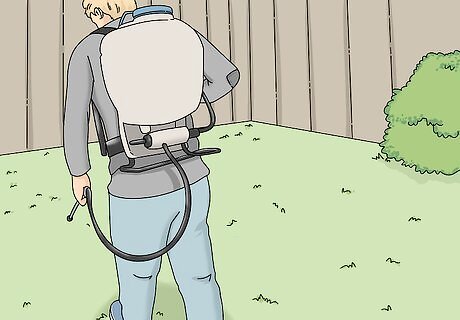
Use herbicides only when needed to avoid killing the sod. It isn’t a great idea to preventatively use herbicides or insecticides—only use them if the sod develops an issue. If you do need to use one of these products, water the sod first and then apply the herbicide or insecticide in the early evening. Sod webworms are common pests but are easily avoided if you keep the sod well-watered.
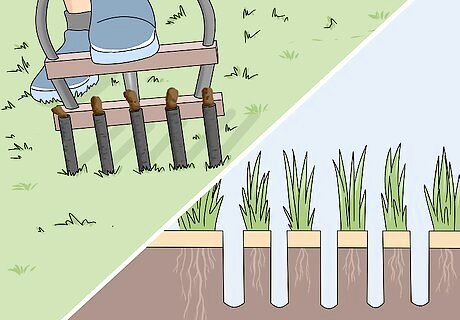
Aerate the sod twice per year. Once in early- to mid-March and once in mid- to late-September are the best times to aerate the sod. If you don’t own an aerator, rent one from a lawn-care service or your local home improvement store. The aerator punches hundreds of tiny holes all over the sod, making it easier for water to reach the roots and encourage continued growth. An aerator keeps the soil under the sod from becoming too compacted, which can inhibit its growth over time.

Verticut the sod once per year for the first 2-3 years. Verticutting is a way to mow your yard that thins out the grass and removes thatch buildup from the previous year to make room for new growth. Switch out your normal lawnmower blades with a special verticut blade, which you can rent from a landscaping service or garden supply store. Mow your yard like you normally would, and then switch the blades back out. If your lawnmower doesn’t have a bag to collect grass clippings, rake them up afterward and dispose of them with your lawn debris. Verticutting increases the density of the sod over time and makes it look more lush and plentiful. A verticutter is also often called a dethatcher.



















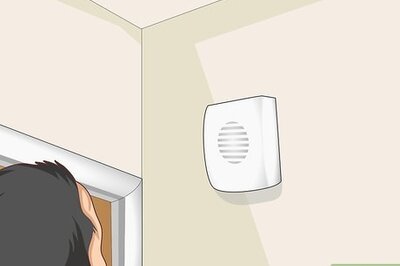
Comments
0 comment